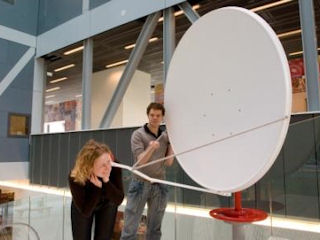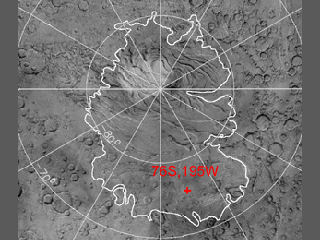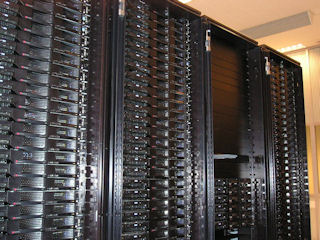Cosmic eavesdropping
Listening is learning. And because eavesdropping is slightly more interesting than just listening, we have set up a ‘whispering dish’ at the Science LinX exhibition. You can capture a sound produced many metres away in this dish. The captured sound is strongly amplified by the shape of the dish. Discover the amazing sounds captured by the dish yourself...

Focal point of sound waves
The Science LinX whispering dish is in fact a ‘parabolic mirror’. A parabolic mirror is an instrument with which you can collect and amplify wave signals. The workings of the device can best be explained using the example of light. If you capture light in a parabolic mirror, the mirror causes the incoming light to be reflected. Thanks to the parabolic shape of the mirror, the reflected rays of light all pass through one single point: the focus. You can generate very high temperatures in the focus; making it a real focal hot spot! The same principle is applied in car headlights, solar panels, old-fashioned bugging devices and lighthouses.

Radio telescopes in the Netherlands
Parabolic mirrors are also used in both optical and radio telescopes (radio signals can also be focused using such a device). There is a fine example located in the middle of the province of Drenthe, where fourteen enormous parabolic mirrors are set up to receive radio signals from space. The dishes each have a diameter of 25 metres and together form a telescope of almost three kilometres in diameter: the Westerbork Synthesis Radio Telescope (WSRT). Researchers from several countries, including our own astronomers from the Groningen Kapteyn Institute, use the WSRT to listen in on objects located far away in the cosmos.

Listening to the Milky Way
The expression ‘listening is learning’ certainly applies to astronomy. By using clever techniques to listen to various wave lengths, our researchers have already unravelled many of the secrets of the universe since the WSRT was first taken into operation in the 1970s. For example, the fourteen parabolic mirrors provided essential information on the size and shape of the Milky Way. In 2000, astronomers used the telescope in the search for the missing Mars Polar Lander. Today our scientists use the WSRT for research on the evolution of remote star systems, for example.

Hydrogen radiation waves
One way of analysing this is by examining the amount and distribution of hydrogen gas in a star system. This simple atom, that was created during the Big Bang, is the building block for the creation of stars and star systems. Stars are often born simultaneously in their thousands out of compact, unstable gas clouds consisting predominately of hydrogen. The majority of all visible matter in space is hydrogen and the WSRT can receive the radiation waves emitted by these hydrogen atoms. Thanks to the WSRT we are learning more and more about the origins of star systems.

Supercomputer
In combination with a new receiver and a supercomputer that processes huge amounts of data really quickly, scientists in the North of the Netherlands can use the WSRT to eavesdrop on outer space.
Links
Colophon
Special thanks to: Hüttinger Exhibition Engineering. Please contact Science LinX if you should have been included in the acknowledgements.
Author
Siëlle Gramser
| Last modified: | 01 October 2015 4.21 p.m. |

